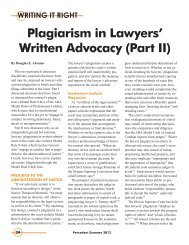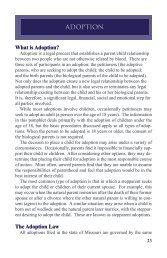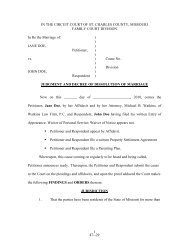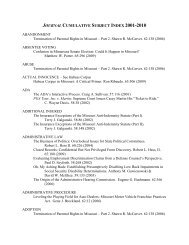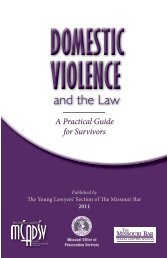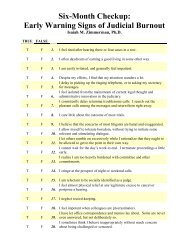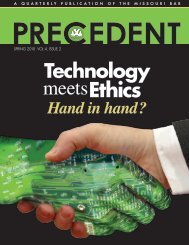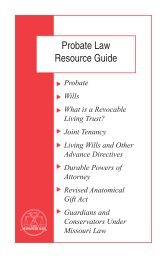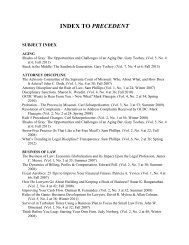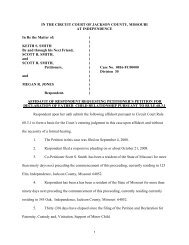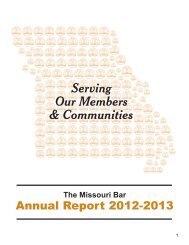Victim Confidentiality Laws Promote Safety and ... - the Missouri Bar
Victim Confidentiality Laws Promote Safety and ... - the Missouri Bar
Victim Confidentiality Laws Promote Safety and ... - the Missouri Bar
You also want an ePaper? Increase the reach of your titles
YUMPU automatically turns print PDFs into web optimized ePapers that Google loves.
<strong>and</strong> exclusion from <strong>the</strong> courtroom<br />
during trial can have a significant<br />
detrimental impact on prosecution<br />
resources. Should <strong>Missouri</strong> legislators<br />
look for guidance in drafting similar<br />
legislation, Arizona <strong>and</strong> Maine offer<br />
effective models to pattern.<br />
Disclosure of Confidential Records<br />
The statutes <strong>and</strong> cases discussed<br />
in <strong>the</strong> preceding paragraphs do not<br />
address a variety of o<strong>the</strong>r confidential<br />
records pertaining to victims <strong>and</strong> <strong>the</strong><br />
professionals who serve <strong>the</strong>m. The<br />
Health Insurance Portability <strong>and</strong><br />
Accountability Act (HIPAA) 43 <strong>and</strong> <strong>the</strong><br />
widely-established protections that<br />
apply to privileged communications<br />
between health care providers <strong>and</strong><br />
patients 44 <strong>and</strong> counselors or <strong>the</strong>rapists<br />
<strong>and</strong> <strong>the</strong>ir clients 45 do not prevent<br />
defendants in criminal cases from<br />
seeking access to <strong>the</strong> medical <strong>and</strong><br />
counseling records of victims on<br />
a regular basis. This is perplexing<br />
to <strong>the</strong> lay witness who has been<br />
led by common underst<strong>and</strong>ing to<br />
assume that “confidential” means<br />
“confidential” when it comes to this<br />
information. Case law indicates that,<br />
upon a defendant’s properly filed<br />
motion, <strong>Missouri</strong> trial courts are to<br />
(1) conduct a hearing on <strong>the</strong> motion,<br />
(2) make a finding that <strong>the</strong> materials<br />
sought are indeed privileged <strong>and</strong> that<br />
<strong>the</strong> defendant has shown that <strong>the</strong><br />
records may contain “relevant <strong>and</strong><br />
material information,” (3) review <strong>the</strong><br />
records in camera, <strong>and</strong> (4) determine<br />
whe<strong>the</strong>r <strong>the</strong> records should be released<br />
to <strong>the</strong> defendant following <strong>the</strong> in<br />
camera review. 46<br />
If a defendant can show that <strong>the</strong><br />
records sought are likely to contain<br />
relevant <strong>and</strong> material information,<br />
such as exculpatory information,<br />
motive to lie, inconsistent<br />
statements, 47 or evidence of factors<br />
that might impede accurate perception<br />
of events such as hallucinations, 48<br />
<strong>the</strong>n <strong>the</strong> trial court will enter an<br />
order compelling production of <strong>the</strong><br />
records (if <strong>the</strong>y are not already in <strong>the</strong><br />
state’s possession) for an in camera<br />
review prior to possible release to <strong>the</strong><br />
defendant. Failure of <strong>the</strong> defendant<br />
to prove that <strong>the</strong> records are known<br />
to exist 49 or to show that <strong>the</strong>re are<br />
specific grounds to support <strong>the</strong><br />
motion to compel has resulted in nondisclosure<br />
of records. 50<br />
Once <strong>the</strong> trial court conducts<br />
an in camera review <strong>and</strong> decides to<br />
release <strong>the</strong> records, a protective order<br />
should be attached to <strong>the</strong> records. 51<br />
This is not yet m<strong>and</strong>ated by law, but<br />
is a matter of judicial discretion <strong>and</strong><br />
wise practice for counsel. Regardless<br />
of whe<strong>the</strong>r a victim consents to use<br />
of his or her records, a protective<br />
order should be utilized to limit <strong>the</strong><br />
viewing <strong>and</strong> redistribution of private<br />
<strong>and</strong> personal information. With a<br />
protective order in place, all parties<br />
are also barred from redistribution of<br />
private information in public court<br />
filings. If a party finds it necessary<br />
to file a motion with protected<br />
documents attached, <strong>the</strong> motion<br />
should be filed under seal with <strong>the</strong><br />
court. Quoting from protected records<br />
within a motion or brief, or attaching<br />
<strong>the</strong> records as an exhibit, defeats<br />
<strong>the</strong> purpose of a protective order if<br />
not filed under seal <strong>and</strong> may subject<br />
counsel to sanctions for violating <strong>the</strong><br />
protective order. 52<br />
There is always <strong>the</strong> risk of<br />
accidental disclosure of confidential<br />
or protected information, especially<br />
in lengthy, contested cases. Any<br />
number of scenarios are possible.<br />
When a protected victim’s full name<br />
or address ends up on a witness<br />
list in <strong>the</strong> court file, or when a law<br />
enforcement officer uses a victim’s<br />
name in a search warrant that<br />
becomes public, court clerks must be<br />
notified promptly of <strong>the</strong> disclosure<br />
March-April 2013 / 81



